The best way to heat a house is with bimetallic radiators: with the lightness of aluminum and the durability of steel
You are viewing the section Bimetallic, located in the large section Types.
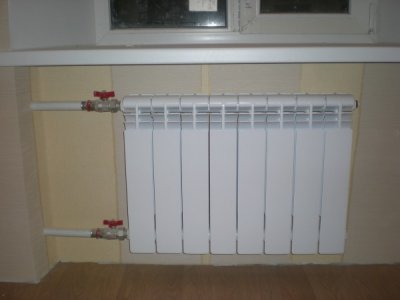
Heating radiators pass the coolant inside themselves, transferring its energy to the environment. Those of them, the bodies of which are not uniform in thickness — made from two alloys, they are called bimetallic.
Characteristics of the combined material are determined by the best properties of the substances from which it is composed.
Thanks to the aluminum layer, the bimetallic device gives off heat well, being compact and lightweight. It owes its durability and wide range of applications to the steel component.
Content
Operating principle, advantages and limitations
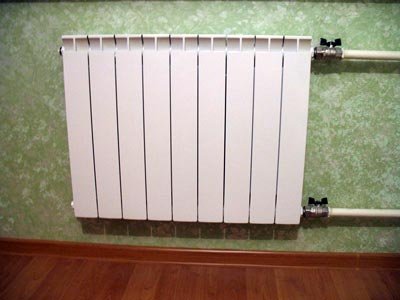
Radiator water heating is considered traditional. Main elements of the system:
- pump (if water pressure movement is selected);
- heat generator (hot water boiler);
- capacitive water heater (stabilizing the temperature of the liquid);
- pipes (thermally insulated, if heat loss along their route is undesirable);
- shut-off and control valves (thermostatic valves, balancing valve, differential pressure regulator, etc.);
- measuring instruments (pressure gauges, thermometers, fittings);
- heating elements - batteries.
Steel, cast iron, aluminum — traditional materials for batteries. A bimetallic radiator consists of steel pipes that conduct the coolant inside them, and an aluminum body that transfers heat to the room by convection and radiation.
What are the advantages and disadvantages of the devices, their prices
In general, the device is equipped with advantages typical for steel and aluminum structures:
- The body gives off heat well, due to the high thermal conductivity of the walls (unlike a cast iron radiator).
- With low metal consumption the strength of the device is sufficient to withstand high hydrostatic pressure network heat carrier, probable hydraulic shocks (due to the steel core).
- The radiator does not require such strict control of water acidity, like aluminum (pH 7-8): the metal that comes into contact with the coolant is more resistant to corrosion.
- Bimetal is wear-resistant, has impact strength.
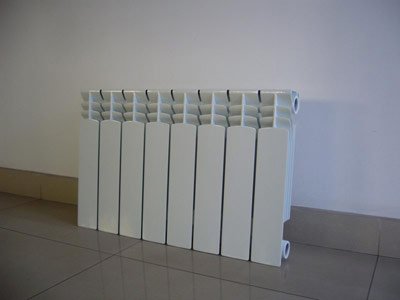
- The volume of heating liquid in the radiator is small - 2-3 times less, than in aluminum. This allows you to quickly change the temperature in the room.
- Bimetallic batteries stand out for their modern design, the ability to select the desired configuration.
- Bimetallic radiators differ from cast iron radiators ease of surface cleaning, low weight, compactness, and ease of installation.
High cost — a noticeable drawback of the bimetallic unit. It is on 12-20% exceeds the price of aluminum devices. One section of a Russian-made radiator costs 400-800 RUR., Italian - 700-900 RUR., Chinese - from 300 RUR
Performance indicators by which The steel-aluminum heat exchanger is inferior to others:
- Surface non-isothermal.
- Water needs to be purified and prepared more thorough than for cast iron products.
- Compared to steel, bimetal lower response speed to temperature changes, less heat radiation — in favor of convection.
Device
Main performance characteristics of the radiator are determined by its design and wall thickness.
The pipes (two horizontal collectors connected by one vertical one) are filled with aluminum alloy under pressure in a special workshop. This is how a monolithic product is formed from a multilayer material.: steel frame inside an aluminum body.
The outer layer is given a complex shape during the casting process. — in the form of a developed system of ribs. The device acquires a large heat-dissipating surface. The larger the contact area between the battery and the air, the more heat the device will give off.
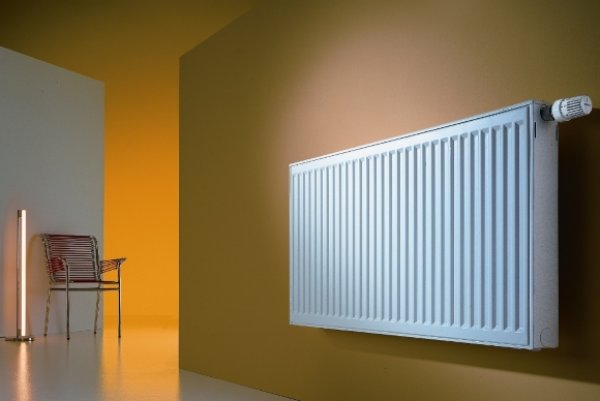
Photo 1. Monolithic bimetallic radiator. The product is a single-piece structure.
Semi-metallic radiator
Bimetallic devices in which the horizontal coolant channels are made of aluminum alloy are called semi-bimetallic. This feature gives the unit some disadvantages. aluminum radiators:
- sensitivity to water acidity;
- abrasion of horizontal collectors mechanical inclusions;
- release of hydrogen upon contact with water — the cause of air locks, which reduce the efficiency of heating;
- unacceptability of use in a house with central heating (due to the presence of additives in the coolant).
Owners of houses with an individual heat source, with water without impurities and acidity pH 7-8 They do not remain at a loss and value semi-metallic batteries for their light weight.
Monolithic or sectional
The dimensions and power of the water heat exchanger are specified by the manufacturer if its products are monolithic radiators. One-piece structures last longer, withstand greater hydrostatic pressure.
Production of individual sections provides the buyer with the opportunity to select the required quantity. The sections are connected to each other with steel nipples in factory conditions. The joints are sealed with gaskets made of heat-resistant rubber that can withstand temperatures up to 200 °C.
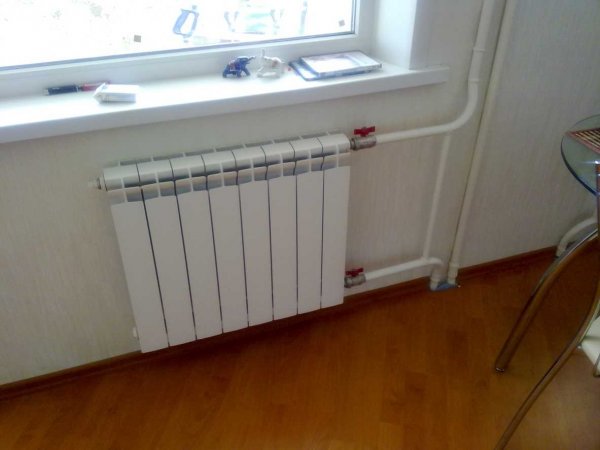
Photo 2. Bimetallic sectional radiator. The device consists of separate parts, they can be added or removed.
Sectional radiators are less durable due to the increased number of connections, require a more gentle operating mode. In terms of power, monolithic and sectional devices are equivalent.
Attention! Each radiator has its own limitations for use. Read the contents of the technical data sheet should be done before purchasing.
Causes of uneven heating
One of the characteristics of a radiator is the degree of uniformity of temperature distribution over the area of the heat exchange surface. The reason for non-isothermality lies in the design of the radiator, the heterogeneity of the material by thickness:
- The casing fins are quite long. The parts of the fins that are far from the collector are significantly colder than the coolant.
- The contact between the steel frame and the aluminum fins is not perfect a priori, and weakens during operation. In foreign-made products, the initial thermal performance decreases over time by no more than 2-3%.
- The heat transfer efficiency of the middle and outer sections is different. The shorter the radiator, the smaller this difference.
How to choose a bimetallic heating battery
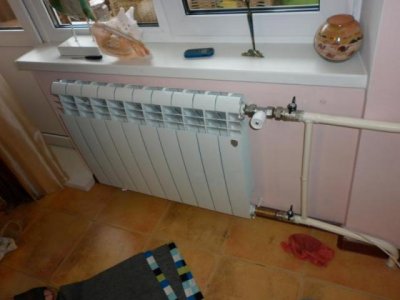
Selection of heating devices for water heating is determined by several parameters:
- type of system (pressure or non-pressure);
- working and test pressures;
- coolant;
- heating boiler capacity;
- hygienic design of the heat exchanger;
- location of the battery in the room;
- financial capabilities and aesthetic preferences of the buyer.
Bimetallic radiators, like steel ones, are suitable for passing water moved through pipes by a pump. In heating systems with natural circulation of the coolant, the work of the steel core is short-lived. The gravity flow and open expansion tank contribute to the saturation of the coolant with oxygen, causing corrosion of the metal.
Reference. One liter of coolant, forced into circulation by a pump, contains 0.2-0.4 g oxygen (V 10-20 times greater than the calculated value). Therefore, if possible, it is worth preferring modern radiators with an internal anti-corrosion layer.
In Europe the test pressure exceeds the working pressure by 30%. In Russia the system is tested in a more severe mode, exceeding operating parameters by 60%. Such discrepancy can have a detrimental effect on imported steel-aluminum radiators if they are not adapted to Russian regulatory conditions.
Is it acceptable? contact of the steel core with water from the central heating network, or with water enriched with antifreeze additives, the manufacturer reports in the technical data sheet, application recommendations. The permissible range of acidity values is also indicated (for example, 7-9.5).
The capacity of the system with the selected heat exchangers must correspond to the capacity of the heating boiler. In preliminary calculations, the specific volumetric capacity of the heating system is taken as 15 l / 1 kW.
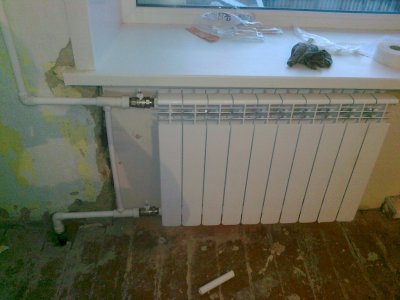
The volume of the system consists of the following capacities:
- hot water boiler;
- expansion tank;
- pipelines (supply, discharge);
- heating devices.
The capacity of heat pipes is calculated by multiplying its length by the cross-sectional area of the pipe.. The volume of the heat exchanger is specified in the technical data sheet. By dividing the total volume (l) by 15 (l/kW) obtain an approximate calculated heat output of the water heater. (For example, for 600 l - 40 kW).
The dimensions of a bimetallic radiator depend on the size of the niche allocated for its installation.. Gap between the bottom of the battery and the floor, at least 6 cm is allowed, to the wall can't leave less 3 cm.
Location of the heating device creates a thermal curtain under the window on the path of outside air, prevents condensation on the glass, ice. In this place, the radiator is effective if its length is 0.5-0.75 width window opening. Up to the windowsill leave not less than 10 cm.
Laconic design is a distinctive feature of heating elements made of aluminum. Foreign manufacturers provide the opportunity to choose the color of the coating. In addition to snow-white devices, cream, gray and black models are in demand.
Calculation of the number of sections
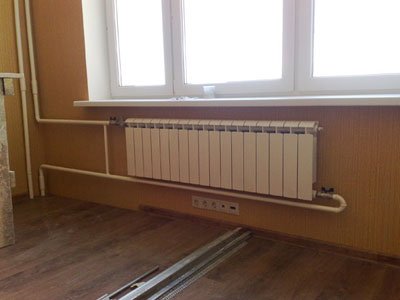
The purpose of heating a building is tocompensate for heat loss and maintain air temperature indoors at a given level.
Owners of private housing trust a specialist to calculate the number of sections. There is also a simplified formula. As a rule, heat loss of a well-insulated house do not exceed 75 W/(m2 ? °C).
By multiplying this figure by the area of the room and dividing by the heat output of the radiator section, you get an approximate number of sections. For example:
- area of a room in a house with autonomous heating 20 m2;
- heat output of the section of the selected model 120 W;
- approximate number of sections - 20 × 75 / 120 = 13.
An apartment building usually loses not more than 100 W / (m2 ? °C). Then, for 20 meter rooms will be required 20 x 100 / 120 = 17 sections of the same model.
Thickness of one section - from 8 to 10 cm, capacity — 0.2-0.3 l, heat transfer - 130-200 W, weight - 1.2-2 kg (cast iron section weighs about 8 kg). The maximum number of sections varies depending on the model: from 6 to 20.
The best bimetallic radiators
Popular brands bimetallic radiators:
- Atlant, Global, Royal Thermo (Italy);
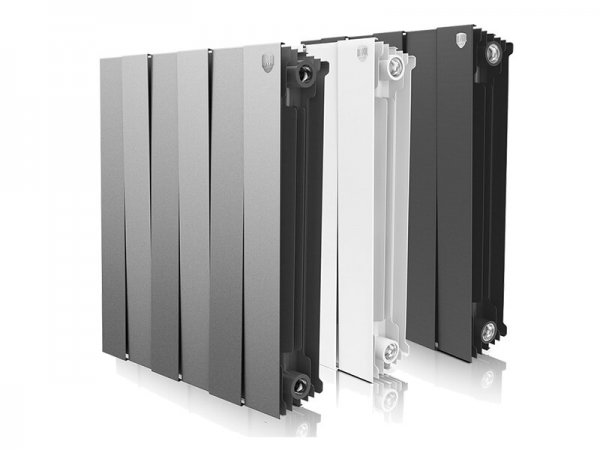
Photo 3. Bimetallic radiators in black and white from the manufacturer Royal Thermo. The products are made in an original designer style.
- Rifar, Halsen, Oasis RU (Russia);
- Germanium (China).
Attention! It is advisable to choose foreign-made bimetallic radiators, if all other elements of the home heating system are imported.
Domestic two-metal radiators have lower technical and economic indicators than imported ones. The reason is in the design flaws of the device, outdated production technologies, and equipment.
Useful video
Watch the video to learn how to choose the right bimetallic heating radiator.
Effect with comfort
With a mass of sections 2-4 times less than cast iron a bimetal radiator will give 7-20% more heat (1500-1700 W). An increased heat transfer coefficient is recognized as an attribute of energy-efficient housing.
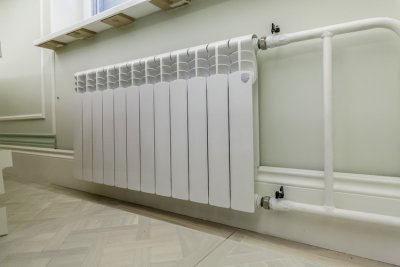
An important advantage of radiators with a large number of fins is low body temperature (40-45 °C). Heating occurs in a mode that is gentle on the microclimate and safe for the inhabitants of the home.
Cost of bimetallic batteries makes its use in a private home impractical, where water does not have additives, the pressure in the network is low.
But, when coming to a country house for the weekend, bimetal will have to heat a significantly smaller volume of coolant than aluminum, cast iron. With periodic heating low system inertia heating is profitable.











Comments